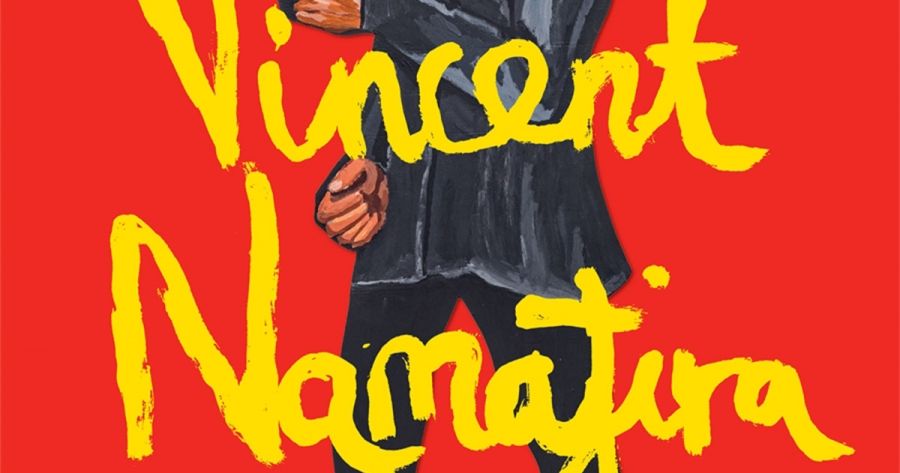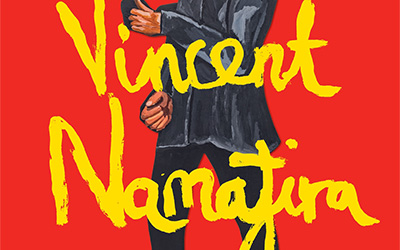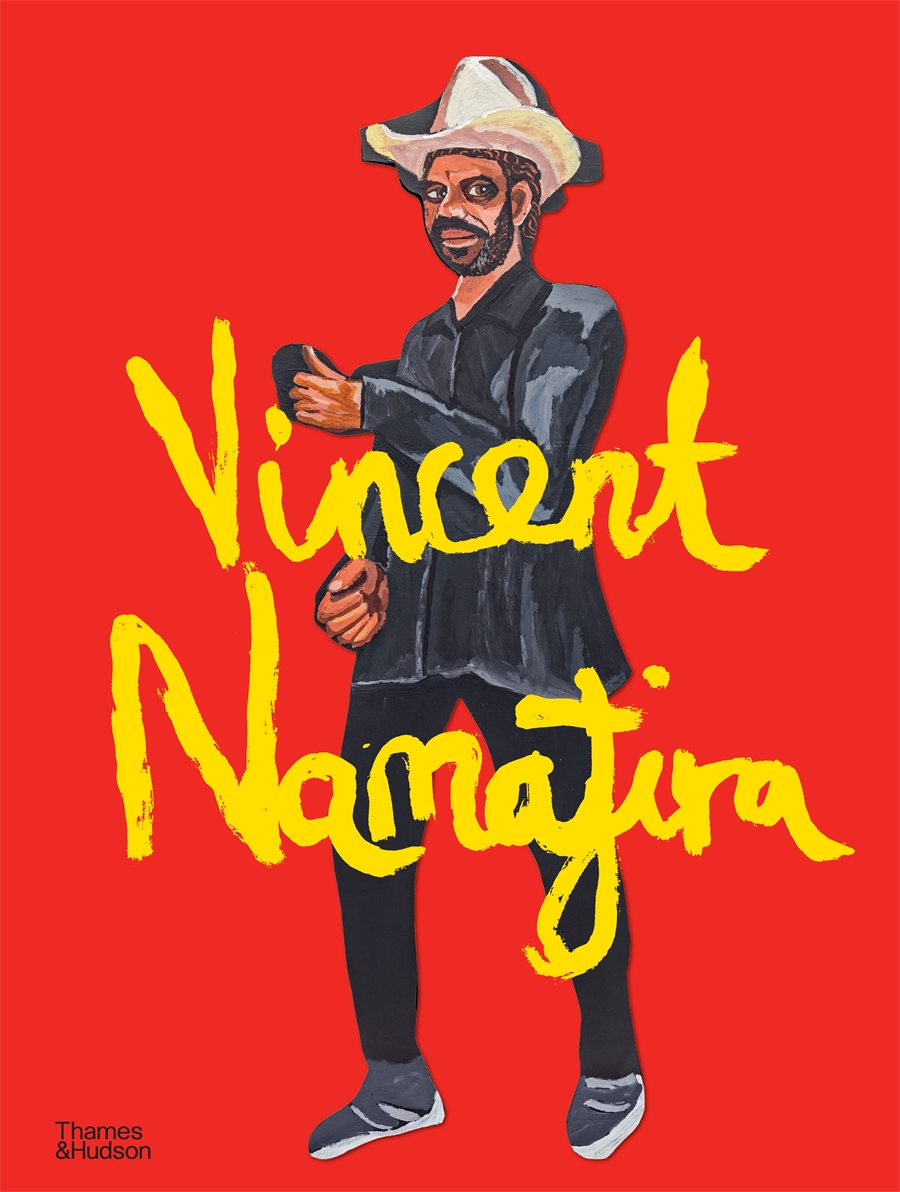
- Free Article: No
- Contents Category: Art
- Review Article: Yes
- Article Title: A spectacular tome
- Article Subtitle: Vincent Namatjira’s humour and intense vision
- Online Only: No
- Custom Highlight Text:
At last a spectacular tome for the many fans of Vincent Namatjira, one that will also win him new admirers. Originating from an exhibition at the Tarnanthi Festival and the Art Gallery of South Australia, this beautifully laid-out book from Thames & Hudson Australia captures the humour and intense vision of Namatjira’s career to date.
- Featured Image (400px * 250px):

- Alt Tag (Featured Image): Roger Benjamin reviews ‘Vincent Namatjira’ edited by Vincent Namatjira
- Book 1 Title: Vincent Namatjira
- Book 1 Biblio: Thames & Hudson, $90 hb, 256 pp
- Book 1 Cover Small (400 x 600):

- Book 1 Cover (800 x 1200):

Namatjira uses the mediated photographic image that brings the world into his home in Indulkana, South Australia. Unlike the images he creates from live sitters, photographs of celebrities are rendered into two dimensions – they are both processed and submissive images. His pantheon of politicians (Tony Abbott), country singers (Charlie Pride), and rock and rollers (AC/DC’s Angus Young) arise from press photographs, superseding them with a new entertainment value. No two portraits of Namatjira’s great-grandfather Albert Namatjira (the celebrated Aranda landscapist whose impact on Indigenous Australian art is incalculable) look the same. The features of Albert’s face twist this way and that; the shape of his head becomes unstable, as does the very idea of resemblance. The same is true of Namatjira’s many Queen Elizabeths, cast as a bejewelled dowager. Does her smiling maw have a sinister edge, as in Destiny Deacon’s Whitey’s Watching? Or is there a residual fondness for the aged matriarch, despite Namatjira’s clear repudiation of neo-colonial Anglo-Australia?
The book’s earliest works date back to 2014, the early years of Namatjira’s arrival on the art scene. I first saw his work in 2016 at ‘Nganampa Kilipil – Our Stars. Art from the Anangu Pitjantjatjara Yankunyjatjarra Lands’ – a big Iwantja Art Centre exhibition at Hazelhurst Regional Gallery. The little-known painter was making an ironic series of small pictures that documented events such as the landing of Captain Cook at Gamay, or visits of the Crown to Australia (including the occasion when Albert Namatjira was presented to the newly crowned queen). Namatjira’s humour was already undeniable, and he went on to posit the absurd incongruity of the cosseted monarch in the breathtaking Centralian scenery. As he writes in the book: ‘Cook and the Queen are both displaced and totally out of their comfort zone in my Central Australian landscape – they’re turning pink in the heat and their power and status doesn’t mean much here.’
Namatjira’s preference for thematic series is used to organise the book across eight chapters: Albert; Leaders; Footy; Music; Power; Royals; Cook; and Myself. Namatjira paints what he loves (Albert, Footy, and Music) and what he ridicules (Leaders, Royals). The chapter ‘Leaders’ begins with a set of colour portraits of Australia’s eight richest people, starting with Gina Rinehart (Australia’s wealthiest person and landowner of vast tracts of unceded Country). The artist poses for a photo in front of his ‘Richest’ panels propped against a dusty tin shed in Indulkana. Symbolically speaking, the smiling, handsome Namatjira has ‘their peckers in his pocket’.
One has to laud the way the artist has determined the format of this book and guides the reader through its beautifully laid-out pages. I am reminded of the late Murri artist Gordon Bennett’s brilliant first monograph, its theorised autobiographical text coupled with art historian Ian McLean’s learned appraisal. In contrast to that intellectual heft, Vincent Namatjira is mostly the artist’s own informal but gutsy writing, the concession to art history and criticism represented in four brief essays. Two of the essays are by artist friends of Namatjira: Tony Albert, with whom he collaborated on a joint pop-up figure book, and, more surprisingly, Ben Quilty, who painted alongside Namatjira in 2022. Balancing these are two curators’ essays: a short piece by the NGA’s Bruce McLean, and AGSA’s Indigenous team of Nici Cumpston, Lisa Slade, and Gloria Strzelecki, covering Vincent’s recent mural-sized canvases, painted outdoors on Western Aranda country.
Unlike his great-grandfather, who was born and usually lived on tribal lands, Vincent Namatjira was raised at Mparntwe (Alice Springs) and Ntaria (Hermannsburg), but soon became exiled and displaced. After the tragic death of his mother, he was sent with his sister into Perth’s foster-care system. It wasn’t until his late teens that Namatjira returned to Western Aranda country, only then learning of the connection to his famous relative. The young man was reintroduced to Country and culture by Western Aranda elders like Jimmy Pompey, a Yankunytjatjarra lawman, musician, and painter who had worked for decades as a stockman.
The theme of return to Country figures strongly in recent works, with Namatjira placing himself and, wittily, foreign notables in the bush. One of the best is Welcome to Indulkana (2018): the artist in his old green utility (based on Albert’s famous art truck) waving an Aboriginal flag to welcome a grotesque, orange-haired mannikin (Donald Trump) and a whimsical bare-chested horseman (Putin, from his famous promotional image). Another cracker is the three-metre canvas Vincent and Vincent (2022), of the iconic landform of Rutjipma (Mt Sonder, made famous by Albert’s watercolours). On this grand scale the painter achieves a muscular, open-brushed style in a palette based on the pink rocks and powdery white ghost-gums of the region. Standing alongside a black-hatted Namatjira is another avatar: Vincent van Gogh himself. The Dutch genius of the passionate brushstroke is there as a reflective, pipe-smoking witness. Imagine it! What would van Gogh, who sought Japan in the blazing light of Provence and turned the Alpilles ranges into semi-human forms, have made of the Aranda’s Tjoritja (Macdonald Ranges)? This book propels us all into the worlds of Vincent Namatjira, weaving ways of culture-making forward, backward, and in upon each other.


Comments powered by CComment